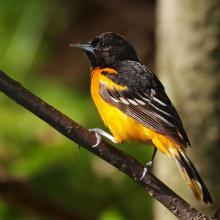

Join BirdNote tomorrow, November 30th!
Illustrator David Sibley and actor H. Jon Benjamin will face off in the bird illustration battle of the century during BirdNote's Year-end Celebration and Auction!
Not all blackbirds are mostly black. This Baltimore Oriole is orange! It’s named after Sir George Calvert, First Lord of Baltimore, whose coat-of-arms carried a gold and black design. In spring and summer, you may see these orioles in the Midwest and eastern US, lighting up the trees where they nest. If you're lucky enough to live near Baltimore Orioles, entice them to your feeder with half an orange.
BirdNote®
The Baltimore Oriole - The Blackbird with the Aristocratic Name
Written by Ellen Blackstone
This is BirdNote.
[Song of the Baltimore Oriole]
When I say the word, "blackbird," what sort of bird do you picture? Maybe the familiar Red-winged Blackbird that sings in the marsh? [Song of Red-winged Blackbird] Well, not all blackbirds are mostly black. One is orange and even has an aristocratic name: the Baltimore Oriole.
[Song of the Baltimore Oriole]
This gorgeous golden-orange and black bird took its name from Sir George Calvert, First Lord Baltimore [heraldic music]. His coat-of-arms carried a gold and black design. [Song of the Baltimore Oriole] Baltimore Orioles eat insects and fruit, but they're fussy. They go mostly for vividly colored fruit.
For nesting material, on the other hand, bland is better. The female – who does all the …architectural work – bypasses colorful threads and fibers and instead chooses dull colors. She's a much drabber orange and blends in with the background while incubating her eggs.
[Call of the Baltimore Oriole]
In spring and summer, you may see these orioles in the Midwest and eastern US, lighting up the leafy trees where they nest.
[Song of the Baltimore Oriole]
You can cater to the particular taste of these beautiful birds. If you're lucky enough to live near Baltimore Orioles, entice them to your feeder with half an orange!
[Song of the Baltimore Oriole]
For BirdNote, I'm Michael Stein. [Go out with heraldic music]
###
Per Laura Erickson, it's best to save the grape jelly for spring and fall migration, when migrating birds need the extra calories. Then, serve up a small amount in a small container, so that the birds don't get stuck. Thanks!
Royal Entry, from the album “Imperial Fanfares,” published by Naxos 2004
Bird sounds provided by The Macaulay Library at the Cornell Lab of Ornithology, Ithaca, New York. Song of the Baltimore Oriole [12483] recorded by A.A. Allen; song of Red-winged Blackbird [57196] recorded by W.W. H.Gunn; call of Baltimore Oriole [12493] recorded by R.C. Stein.
BirdNote's theme music was composed and played by Nancy Rumbel and John Kessler.
Producer: John Kessler
Executive Producer: Chris Peterson
© 2014 Tune In to Nature.org June 2014/2016/2021 Narrator: Michael Stein
ID# BAOR-01-2014-06-23 BAOR-01








